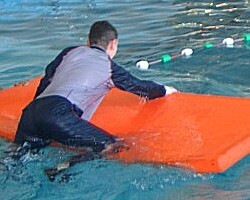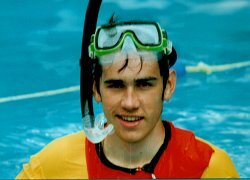Swim ABC - Dutch Swimming Lessons
The Swim ABC (Zwem ABC) teaches essential survival skills as an exciting fun sport. Survival Swimming in the Netherlands is an essential part of water safety education.
From age four kids learn in three stages how to swim and survive accidents. All these training programmes are very popular because they are great fun. Many exercises are offered in a game, because that's the best way to learn. Don't think that they are just playing in the water. Each game has a purpose.
From the very first swimming lesson attention is paid to safety and survival. This is done by trial and error, jump into the water and climb out of the water.
Afterwards they learn the swimming strokes. In addition to they will continue to pay close attention to all kinds of exercises in deep water, such as different ways of going into the water, swim underwater, climbing and scrambling onto a raft or onto the poolside, and go to the bottom.
No matter whether it is a river or swimming lake,
bathing in clear waters or entering ice areas,
it all requires special skills.
The participants learn to know their limits, as well as
to take care of themselves and others so as not to get into dangerous situations.
Swim ABC Objectives
The Swim ABC teaching method has already a long and successful tradition in the Netherlands. In a watery country it is a must that everyone can swim and can also help in exceptional situations.
That is why learning the Swim ABC swimming skills is of great importance. The goals are swimming skills, swimming safety and, of course, fun in the water. Ongoing training makes survival swimming an exciting fun sport.
Long Waiting Times for Lessons
The wet element has a magical attraction on children. For most there is no greater fun than to splash in the water and to romp with friends or "test" the ice surfaces in the winter.
For parents, it is a reassuring feeling to know that their children are able to act well even in dangerous situations. Schools, swimming pools and parents have realized this, so it is not surprising that there are long waiting times to participate in such a course.
Parents rescue Kids, Kids rescue Parents
We put a strong emphasis on parents joining their kids and teens in this course.
When parents can rescue their kids then you have good safety in the family.
When kids learn to rescue their parents, they are set for life,
enjoying fun in the water safely.
Swim ABC Diplomas
A shortened translation of the Dutch test syllabus by the National Swimming Council, the Nationale Raad Zwemveiligheid (NRZ), is shown below. Adjust it to your needs and abilities.
Swimmers wear clothes during these swim lessons which can help one day with a self rescue. If it comes to a misfortune, they do not panic but are able to assess the situation and know the correct behaviour. All clothing must be unlined to avoid air or water pockets which could get in the way.
The A-Diploma
This class (48 hours) teaches basic swimming skills. The main swimming strokes and skills are included.
Requirements for Swimming A-Diploma:
- Swim in T-shirt and shorts.
- From some height jump into the water go forward feet first.
- 15 seconds treading water.
- Swim 12 meter breaststroke, diving under a line.
- Do a half-turn around the longitudinal axis.
- Swim 12 meters single backstroke.
- Climb out of the water independently on the side.
The B-Diploma
This class (12 hours) teaches swimming fully clothed, more swimming strokes, and simple rescue skills. This is more fun than the class before.
Requirements for Swimming B-Diploma:
- Swim fully clothed for the whole test.
- From some height jump into the water go forward feet first.
- Do a half turn under water.
- Tread water for 15 seconds.
- Swim 25 meters breaststroke.
- Swim underneath an inflatable raft or floating mattress.
- Do a whole turn around the longitudinal axis.
- Swim 25 meters single backstroke
- Climb out of the water independently on the side.
Clothing requirements for B-Diploma:
Shirt or blouse with long sleeves.
Pullover, sweatshirt, or hoodie.
Long trousers (not skin tight).
It is permitted for candidates instead of a trouser to wear a dress or skirt which must reach the knees.
Shoes (plastic and sports shoes are allowed).
Shoes with no real soles, such as ballet slippers, are not allowed.
The C-Diploma
The class (12 hours) teaches winter swimming with more clothes, boats and more. It is the most fun of all Swim ABC classes.
Requirements for Swimming C-Diploma:
- Go into the water from the side with a forward roll.
- Tread water for 15 seconds.
- 30 seconds float (HELP-position) with use of a device.
- Launch off the side with a jump of choice.
- Swim 50 meters breaststroke.
- Swim underneath an inflatable raft or floating mattress.
- Climb over an inflatable raft or floating mattress.
- 50 meters single backstroke.
- Climb out of the water independently on the side.
Clothing requirements for C-Diploma:
Unlined nylon rain jacket or anorak with long sleeves.
T-shirt or blouse with long sleeves.
Long trousers (not skin tight).
It is permitted for candidates instead of a trouser to wear a dress or skirt which must reach the knees.
Shoes (plastic, leather and sports shoes are allowed).
Shoes with no real soles, such as ballet slippers, are not allowed.
Security Divers
Lifeguards can act as security divers by keeping an under water eye on swimming lessons. We call them the "safety sharks". They move slowly, but act fast if a swimmer gets in difficulty.
Teachers Create Adventure Variations
In a lifeguarded pool the teachers go into the water with the class. It gives participants confidence when they show all swimming exercises first for the class to copy. For ongoing training they can adapt the survival swimming lessons with an adventure theme. Teachers and students wear the relevant clothes for the adventure to make it fun and interesting.
A "Winter Swimming" lesson in winter clothes simulates an ice rescue with floating mats. A "Jungle Trek" in rain ponchos teaches wading skills, safe water entry and exit.

Winter swimming

Security Diver
Reader Comments
Swim Training Gets Tough
by Fietje from Amsterdam, NetherlandsFrom 7th grade the swimming lessons in my boarding school got fairly tough, with survival swimming, rescues, and strength building. I enjoyed that more than swimming up and down.
We started with kick-boxing in the pool, initially in swimwear, until we learned the skill. This was easy. Then we practiced in PE kit which took a bit more effort but was more interesting. Finally we did it fully clothed, quite hard at first, but I soon got good at it.
Now we have to swim in clothes most of the time which is hard but good fun. We're told to vary the clothes a lot, to get many different experiences. I've worn most of my sportswear in the pool. Swimming in PE kit is easy. We do that at the beginning of each lesson for endurance swimming.
Halfway through each lesson we get fully clothed for resistance swimming.
I like tracksuits best, but jeans and hoodie, joggings suits, or rainwear are fun too.
We have two swimming lessons a week, plus a pool play session most afternoons.
Luckily I have many clothes to swim in or they would never get dry.
My Swimming Lessons
by Rik from Amsterdam, NetherlandsA few years ago I learned how to swim in the local pool. The Swimming Diploma (Zwem Diploma) was offered in three stages (A, B and C) and the Zwemvaardigheids Diploma.
The A-Diploma was easy. Dressed in tee-shirts and shorts we've learned the basic swimming strokes, like breaststroke and front crawl. We also learned how to dive into the water. I did a few belly flops at first, but they didn't hurt because of the tee-shirt. Then the teacher jumped into the water in his hoodie and jogging pants to show us how it is done right. I asked if we could swim in clothes too and he said in the next few lessons we would all swim fully clothed.
The B-Diploma was a bit more challenging but much more exciting. We were asked to wear long trousers and a long sleeve pullover in the water on top of our swimwear. I had never done this before so I put on jeans and a sweatshirt over my shorts and tee-shirt. It was a pleasant surprise when I jumped into the pool with so many clothes on. We learned the backstroke and sidestroke. The games were always the best part of these lessons.
The C-Diploma was even more interesting.
In addition to all the clothes we wore before, we were asked to put on boots and a rain jacket or anorak.
Just for fun we all went under the showers dressed like this.
When I jumped into the water, my rain jacket ballooned with all the air inside
and I was quickly pulled up to the surface.
That was great fun and I did it many more times.
We also learned some rescue skills and what to do if we break into ice.
I learned a lot in those lessons.
After the whole class passed the tests,
we we're advised to continue swimming regularly and continue with the higher swimming skills diplomas,
so that our swimming techniques are further improved and refined.
The swimming teacher gave everyone a Zwem-ABC hoodie which we should always wear in the pool from now on to advertise the course. Everyone seen swimming a full session in their Zwem ABC Hoodies gets their entrance fee refunded.
Now my friends and I always wear our Zwem ABC hoodies when we go swimming.
They keep us warm for longer and make us strong.
Twice a week the local swimming pool runs a swimming session where clothes are mandatory.
I never thought that swimming in clothes is so much fun.
The Zwemvaardigheids Diploma was the next step where the difficulty increases,
both in the skills to learn and the clothes we had to wear.
We learned all kinds of new swim strokes such as butterfly stroke, composite backstroke and turning points, and the chest and back crawl.
Ball skills, including throwing and catching and swimming with the ball were great fun.
Survival swimming was tough where you swim through underwater loops,
or help each other climb out of the water.
We did underwater orientation, where you find your way under water
by swimming from pilon to pilon at a depth of two meters, and you learn to make a backward roll.
Recent Update
When I turned 18 it was time for me to teach lifesaving and survival swimming myself. I took a training course which was very intensive with lots of pool practice, but exciting fun.
We learned the theory and teaching methods followed by intensive pool training. We went through all the elements of the Zwem ABC, and practiced all the different swimming strokes in all kinds of clothes, learning how they affect swimming capabilities.
Teaching
Three times a week I teach the Zwem ABC Diplomas.
An important part are fun teaching methods to keep up the enjoyment and attention of the class.
This involves water games and playful swim competitions to get them used to swimming in clothes.
Teachers are encouraged to occasionally wear funny costumes in the water,
like animal or Pokemon onesies and the like.
Kids love that.
Once the lessons are over, we teachers practice parts of the Zwem ABC in the pool to stay fit and focussed.